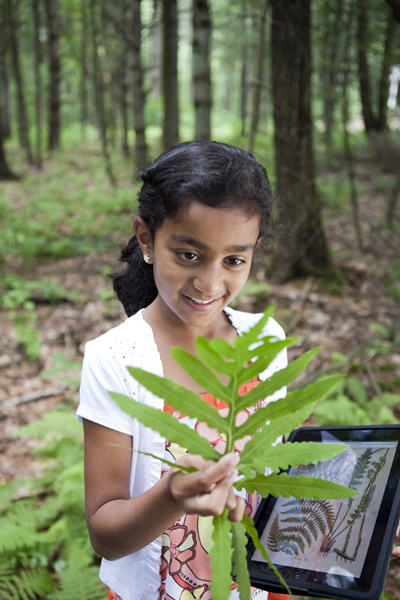
My colleague had a problem. While at a company luncheon, she spoke about her plan to send her 10-year old son to the boundary waters of Northern Minnesota for a weeklong camp. He wanted an iPad. Her dilemma: she couldn't afford both. The rest of the table wasn't so sure, but my vote was swift -- get the kid his iPad. Here's why.
For the author's niece, Apsara, nature and technology aren't mutually exclusive. Image credit: Jessica Scranton.
A recent poll carried out by The Nature Conservancy told us what we suspected. Our kids, future leaders of Spaceship Earth, are simply not getting outside. Nine out of 10 are getting online every single day; shockingly, less than half are getting out into nature even once a week.
That means for more than half of American kids, there are no regular fishing forays, no sandcastles on the beach and no campfires. Given that most East Coasters live just a couple of hours' drive from great national parks and the Atlantic coast, this paucity of nature in our children's lives (dubbed "Nature Deficit Disorder" by author Richard Louv) is hard to understand and harder still to accept.
The headlines are frighteningly clear, but just what to do about it is another matter entirely.
The obvious scapegoat is technology. Social media and the i-tools that help us immerse under its mirrored surface is a great big target. But demonizing technology and social media would be a mistake.
The poll, you see, has a silver lining.
Youth are not ignorant of nature's plight. Far from it! Dismissed by green pundits as "iPod idiots," it turns out that our kids do care -- and most are unhappy with the state of the environment and want it protected for its intrinsic value, even at the cost of jobs. They also, rightly, blame adults for its dismal state, though optimistically feel challenges could be overcome if we act now. Not surprisingly, children who are exposed to nature more value it more, but most simply lack access.
In a time when we are treating our kids in great numbers for an expanding list of behavioral disorders, nature, it seems, provides soothingly cheap relief to hyper-kinetic neurons. As our reliance on sugars, fats and chemicals strengthens, our poll found that nature overwhelmingly makes children feel "peaceful, calm, free and happy." An unstructured walk in the woods is about the best break a frazzled mind can get.
Our kids also think that saving nature is the right thing to do. Almost 90% say it's "cool" to protect the environment. Imagine a politician or issue with that kind of approval rating!
So while nature may be inaccessible to many kids, their love for it, their commitment to saving it, their desire for meaningful engagement still echoes. That is encouraging enough. Where they get this "ethic" is complicated -- perhaps it's parents or school, but it may also be television and (gasp) social media.
The Nature Conservancy has launched a critically acclaimed program called LEAF, targeting inner city youth with otherwise little opportunity to access nature. Led by Brigitte Griswold and with support from the Toyota USA Foundation, the program provides intense mentoring of kids at Conservancy preserves. Lives, it turns out, are consequently transformed. (The program was recently profiled on CBS' The Early Show.)
In Indonesia, the Conservancy, along with Conservation International, sail the 100 ft Kalabia. The ship is a floating nature school exposing Indonesian children to what lies beneath their emerald waters. Over 3,000 have sailed on board.
These efforts are no doubt worthwhile. Yet, environmental groups struggle to scale up such programs. One thousand or 10,000 kids is still a drop in the bucket.
Only through technology can we have a hope of reaching the millions who yearn for meaningful engagement. With support from the Morgridge Family Foundation, The Nature Conservancy is launching an experimental program based on the following premise: If you can't take every kid into nature, then technology can help bring nature to the kid. By using interactive white board technology, conservation content can be brought directly into the classrooms. The obvious advantage is that millions across cultural divides can be reached, at just pennies per child.
Getting youth out into nature is clearly important. Kids want it, and it does them personal good. But it's also important to engage social tools and technology to create a community experience around valuing, appreciating and enjoying nature. American kids do not lack for passion, they lack for the opportunity to engage.
Our children want to experience nature with friends. They are already wired to social networks. Our "iGadgets" can now go with us to the Serengeti, much less the neighborhood park, and being online no longer means being tethered in the basement. Rather than scolding our kids to unplug, wouldn't it be far better to engage technology to help plug them into nature, our ultimate social network?
